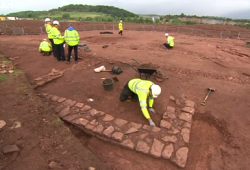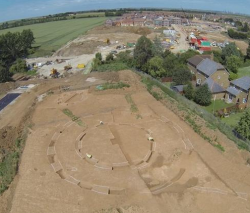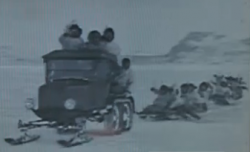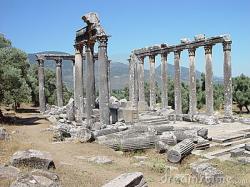INSTITUT SUPERIEUR D'ANTHROPOLOGIE
INSTITUTE OF ANTHROPOLOGY
ONLINE COURSES / COURS A DISTANCE
FALL TERM : OCTOBER 2014
REGISTER NOW
USA – Charleston - Archeologists in South Carolina will look for remaining evidence of a wharf where tens of thousands of slaves first set foot in the United States. The Post and Courier of Charleston reports that Mayor Joseph P. Riley Jr. says researchers will in the coming weeks begin looking for whatever may remain of Gadsden's Wharf. He said there may be timbers or other material under layers of fill. From 1803 to 1807 more than 70,000 enslaved Africans were brought to the wharf at a time when Charleston's population was only 20,000. The first slaves arrived in Charleston in 1670, the year the Carolina colony was founded.
http://www.heraldonline.com/2014/08/28/6269857_researchers-to-seek-wharf-where.html?sp=/100/104/543/&rh=1
ROYAUME UNI –  - Cannington - Archaeologists are studying Roman ruins that have been discovered on the site of a new road in Somerset. Somerset County Council's Steve Membery told the BBC that the site probably belonged to wealthy landowners in approximately AD100. The ruins, which were found during construction of the Cannington bypass, are described as locally important rather than nationally significant so will not prevent the road being built.
- Cannington - Archaeologists are studying Roman ruins that have been discovered on the site of a new road in Somerset. Somerset County Council's Steve Membery told the BBC that the site probably belonged to wealthy landowners in approximately AD100. The ruins, which were found during construction of the Cannington bypass, are described as locally important rather than nationally significant so will not prevent the road being built.
VIDEO = http://www.bbc.com/news/uk-28971071?
ROYAUME UNI –  Iwade - Experts have confirmed they have unearthed a Neolithic henge... in Iwade. The 6,000-year-old prehistoric monument, which is 30m in diameter and consists of a pair of ringed ditches, is said to be "as rare as hen's teeth". Its origins were finally laid bare after months of excavations at a site off Sheppey Way, which is being prepared for a 400-home development.Dr Paul Wilkinson, whose team SWAT Archaeology made the discovery, said: "There are not many of these sites around. "Its purpose is not known, but it may be that the monument was reused as an enclosure for stock management at this time or could formally have been used as a 'sacred way' leading to the Neolithic henge." The outer ring at the Iwade site is thought to be Neolithic, its possible purpose being a ceremonial meeting place. The unbroken inner circle is believed to stem from the Bronze Age and may have been used as a funerary monument to commemorate a dead person or group. Near the rings, a second similar, but smaller monument, was also found by archaeologists. Dr Wilkinson said although discoveries such as the one in Iwade are rare, a Neolithic henge was uncovered in nearby Sonora Fields last year, while in Hollingbourne, an early Iron Age site was revealed.
Iwade - Experts have confirmed they have unearthed a Neolithic henge... in Iwade. The 6,000-year-old prehistoric monument, which is 30m in diameter and consists of a pair of ringed ditches, is said to be "as rare as hen's teeth". Its origins were finally laid bare after months of excavations at a site off Sheppey Way, which is being prepared for a 400-home development.Dr Paul Wilkinson, whose team SWAT Archaeology made the discovery, said: "There are not many of these sites around. "Its purpose is not known, but it may be that the monument was reused as an enclosure for stock management at this time or could formally have been used as a 'sacred way' leading to the Neolithic henge." The outer ring at the Iwade site is thought to be Neolithic, its possible purpose being a ceremonial meeting place. The unbroken inner circle is believed to stem from the Bronze Age and may have been used as a funerary monument to commemorate a dead person or group. Near the rings, a second similar, but smaller monument, was also found by archaeologists. Dr Wilkinson said although discoveries such as the one in Iwade are rare, a Neolithic henge was uncovered in nearby Sonora Fields last year, while in Hollingbourne, an early Iron Age site was revealed.
http://www.kentonline.co.uk/sittingbourne/news/iwade-neolithic-henge-unearthed-22497/
CHINE - Shanggangyang - Archaeologists in central China's Henan Province haveexcavated a large neolithic settlement complete with moats and a cemetery. The Shanggangyang Site covers an area of 120,000 square meters and sits along a river inZhengzhou, capital of Henan, dating 5,000 to 6,000 years back to the Yangshao culture,which was widely known for its advanced pottery-making technology. The site features two defensive moats surrounding three sides. Researchers have foundrelics of three large houses as well as 39 tombs, the large number suggesting severalgenerations resided there, archaeologist Gao Zanling, a member of the ZhengzhouAdministration of Cultural Heritage, said. "The size and population of the settlement, if compared with others in the same era, waspretty large," Gao told Xinhua. Excavation of the site has offered a glimpse into the life in the tribe, including the use ofpits to store food or bury garbage. Researchers also found a variety of crockery wares,including pots, kettles, cups and other tools.
http://english.peopledaily.com.cn/n/2014/0827/c202936-8775341.html?
CANADA –  Nunatsiavut- A team of archeologists in Nunatsiavut say they've found Labrador's first snowmobile — and there are plans in the works to get it back up and running. The snowmobile is a nearly 100-year-old Ford Model T that was converted to ride through snow on skis. Chicago scientists used the makeshift snowmobile during an expedition to Labrador, and it was later abandoned in 1928.
Nunatsiavut- A team of archeologists in Nunatsiavut say they've found Labrador's first snowmobile — and there are plans in the works to get it back up and running. The snowmobile is a nearly 100-year-old Ford Model T that was converted to ride through snow on skis. Chicago scientists used the makeshift snowmobile during an expedition to Labrador, and it was later abandoned in 1928.
http://www.cbc.ca/news/canada/newfoundland-labrador/archeologists-discover-labrador-s-1st-snowmobile-1.2747667
GRECE –  Argolide - The research work of the Terra Submersa expedition at the sea bottom of Argolida, in the Peloponnese, is in progress. Starting from Eretria, headquarters of the Swiss School of Archaeology in Greece, with intermediate stations in Piraeus and Nafplion, the members of the archaeological Terra Submersa expedition ended up in the bay of Argolida‘s valley, where they carry out underwater research. The Greek-Swiss expedition, led by archeologists of the Geneva University in collaboration with the Laténium of Neuchâtel, the Greek Service for Underwater Antiquities, the Swiss School of Archeology in Greece and the Hellenic Center for Maritime Research, aims to explore the prehistoric landscapes that have been submerged by the waters of the Gulf of Argolida, in an attempt to remodel them and identify possible human traces. At the end of the Ice Age, about 20,000 years ago, the sea level was lower than it is today. By remodeling the landscapes that have disappeared, archaeologists hope to understand the dynamics through which coastal zones were populated. The Terra Submersa expedition focused on the Franchti cave, in the northern part of the bay, which was inhabited for 35,000 years, from the Paleolithic to the Neolithic age. “We collected fantastic data, its analysis will take two years of work,” said Julien Beck, the expedition’s head. “The preliminary results are encouraging,” he added. In fact, by mapping the sea bottom, archaeologists found paleobeaches dating back to different periods in prehistory. It is estimated that these beaches were shaped by the inhabitants of the Franchti cave, in which scientists recovered shells and the remains of fish. Furthermore, faults indicating tectonic shifts in the Gulf of Argolida have been detected with the echo-sonar installed aboard the solar-powered ship. These faults could explain the paleobeaches’ difference in depth. Archaeological research also revealed signs of the bed of an ancient river, which is encouraging as ancient civilizations used to flourish near water.
Argolide - The research work of the Terra Submersa expedition at the sea bottom of Argolida, in the Peloponnese, is in progress. Starting from Eretria, headquarters of the Swiss School of Archaeology in Greece, with intermediate stations in Piraeus and Nafplion, the members of the archaeological Terra Submersa expedition ended up in the bay of Argolida‘s valley, where they carry out underwater research. The Greek-Swiss expedition, led by archeologists of the Geneva University in collaboration with the Laténium of Neuchâtel, the Greek Service for Underwater Antiquities, the Swiss School of Archeology in Greece and the Hellenic Center for Maritime Research, aims to explore the prehistoric landscapes that have been submerged by the waters of the Gulf of Argolida, in an attempt to remodel them and identify possible human traces. At the end of the Ice Age, about 20,000 years ago, the sea level was lower than it is today. By remodeling the landscapes that have disappeared, archaeologists hope to understand the dynamics through which coastal zones were populated. The Terra Submersa expedition focused on the Franchti cave, in the northern part of the bay, which was inhabited for 35,000 years, from the Paleolithic to the Neolithic age. “We collected fantastic data, its analysis will take two years of work,” said Julien Beck, the expedition’s head. “The preliminary results are encouraging,” he added. In fact, by mapping the sea bottom, archaeologists found paleobeaches dating back to different periods in prehistory. It is estimated that these beaches were shaped by the inhabitants of the Franchti cave, in which scientists recovered shells and the remains of fish. Furthermore, faults indicating tectonic shifts in the Gulf of Argolida have been detected with the echo-sonar installed aboard the solar-powered ship. These faults could explain the paleobeaches’ difference in depth. Archaeological research also revealed signs of the bed of an ancient river, which is encouraging as ancient civilizations used to flourish near water.
http://greece.greekreporter.com/2014/08/27/archaeological-discoveries-at-the-sea-bottom-of-argolida/
TURQUIE –  Euromos - Excavation works in the ancient city of Euromos, located near the city of Milas in the western province of Muğla, have revealed the remains of a 2,300 year-old throne. The ancient city of Euromos is home to some of the most well preserved temples in Anatolia. This year excavation works have been headed by Associate Professor Abuzer Kızıl. Kızıl said they were very excited about the new findings, discovered close to a 3,000-person capacity ancient theater. “[The throne] is a marble seat and was found very close to the theater’s stage. We believe it belonged to a noble person who lived in the city. We have named it ‘proedria.’ There was also a cylindrical altar right next to it. It will be the benchmark for our future excavations. We got chance to analyze the theater better and will continue working on it,” he added. Kızıl also believes the seat may have belonged to a woman due to its relatively small frame, adding “there are hearts and various motifs inscribed [on the chair].”
Euromos - Excavation works in the ancient city of Euromos, located near the city of Milas in the western province of Muğla, have revealed the remains of a 2,300 year-old throne. The ancient city of Euromos is home to some of the most well preserved temples in Anatolia. This year excavation works have been headed by Associate Professor Abuzer Kızıl. Kızıl said they were very excited about the new findings, discovered close to a 3,000-person capacity ancient theater. “[The throne] is a marble seat and was found very close to the theater’s stage. We believe it belonged to a noble person who lived in the city. We have named it ‘proedria.’ There was also a cylindrical altar right next to it. It will be the benchmark for our future excavations. We got chance to analyze the theater better and will continue working on it,” he added. Kızıl also believes the seat may have belonged to a woman due to its relatively small frame, adding “there are hearts and various motifs inscribed [on the chair].”
http://www.hurriyetdailynews.com/ancient-throne-discovered-in-excavations-at-euromos.aspx?pageID=238&nID=70989&NewsCatID=375